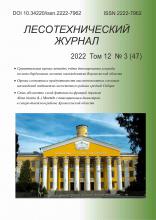Krasnoyarsk, Krasnoyarsk, Russian Federation
Krasnoyarsk, Krasnoyarsk, Russian Federation
from 01.01.2017 until now
Russian Federation
from 01.01.2019 until now
Krasnoyarsk, Krasnoyarsk, Russian Federation
Forest ecosystems, in particular pine plantations, are currently experiencing a complex of negative factors that affect both the condition of plantations and their growth indicators. The purpose of the study was to determine the condition and productivity of suburban pine forests of Krasnoyarsk, as well as statistical regression assessment of carbon concentration in the growing, dying and dried part of the forest stands. The object of research is pine forests of natural origin of Karaulnoe area forestry of experimental forestry of M.F. Reshetnev Siberian State University, located in the suburban area of Krasnoyarsk. Evaluation of sanitary category of pine forests allowed to state mainly "weakened" their condition. Regression analysis ascertained a reliable one-coefficient linear relationship between the carbon of different parts of pine forests and the supply of trunk wood and the completeness of forest stands. In this case, when predicting the carbon of the deadwood part of the stand, it must be divided into two parts: caused by external influences (forest fires, the stage of obsolescence, phyto-pathological conditions) more than 20 tS*ha-1 and caused by natural fall-off to 20 tS*ha-1. As a result, it was found that in high-density, dense pine forests of the subtaiga forest-steppe region of Middle Siberia, the stability of pine forests is due to a complex of factors: age structure (when the active phase of growth in plantations is terminated, indicators of vitality decrease); completeness (high density worsens the condition of trees); stock (growth of the number of trunk wood per unit area contributes to an increase in the drying part of the pine stand); climatic conditions (an increase in temperature during the growing season and a decrease in the amount of precipitation).
pine, condition, high fullness, stock, carbon, climate
1. Vaganov E. A., Porfir'ev B. N., Shirov A. A., Kolpakov A. Yu., Pyzhev A. I. Ocenka vklada rossiyskih lesov v snizhenie riskov klimaticheskih izmeneniy. Ekonomika regiona. 2021; 17(4): 1096-1109. DOI: https://doi.org/10.17059/ekon.reg.2021-4-4. EDN: https://elibrary.ru/IQGRGN
2. Zamolodchikov D. G., Grabovskiy V. I., Shulyak P. P., Chestnyh O. V. Sovremennoe sokraschenie stoka ugleroda v lesa Rossii. Doklady Akademii nauk. 2017; 476(6): 719-721. URL: https://www.elibrary.ru/item.asp?id=30267873. DOI: https://doi.org/10.7868/S0869565217300259; EDN: https://elibrary.ru/ZMJDPP
3. Kokorina E. G., Vays A. A. Eskiz tablicy hoda rosta modal'nyh sosnovyh nasazhdeniy na osnove principov dinamicheskoy tipologii. Hvoynye boreal'noy zony. 2021; 39(4): 257-262. URL: https://www.elibrary.ru/item.asp?id=47174617&.
4. Lipka O. N., Korzuhin M. D., Zamolodchikov D. G. i dr. Rol' lesov v adaptacii prirodnyh sistem k izmeneniyam klimata. Lesovedenie. 2021; 5: 531-546. DOI:https://doi.org/10.31857/S0024114821050077. EDN: https://elibrary.ru/OWSSBF
5. Matveev S. M., Timaschuk D. A. Dendroklimaticheskiy analiz 200-letnego drevostoya sosny obyknovennoy v Voronezhskom biosfernom zapovednike. Lesovedenie. 2019; 2: 93-104. DOI:https://doi.org/10.1134/S0024114819020074. EDN: https://elibrary.ru/VUFBCG
6. Matyushevskaya E. V., Kiselev V. N., Yarotov A. E. O prichinah usyhaniya sosny v Belarusskom poles'e. Zhurnal Belorusskogo gosudarstvennogo universiteta. Geografiya. Geologiya. 2021; 2: 82-90. DOI: https://doi.org/10.33581/2521-6740-2021-2-82-90. EDN: https://elibrary.ru/PHJJDK
7. Tatarincev A. I., Skripal'schikova L. N. Ekologo-fitopatologicheskoe sostoyanie sosnovyh dendrocenozov v lesah Krasnoyarskoy gruppy rayonov. Hvoynye boreal'noy zony. 2018; 36(4): 322-333. Rezhim dostupa: https://www.elibrary.ru/item.asp?id=36728806. EDN: https://elibrary.ru/YSZSLB
8. Chivulescu Ș., Pitar D., Apostol B., Leca Ș., Badea O. Importance of Dead Wood in Virgin Forest Ecosystem Functioning in Southern Carpathians. Forests. 2022; 13(3): 409. DOI: https://doi.org/10.3390/f13030409. EDN: https://elibrary.ru/MSQDZL
9. Harmon, M. E., Fasth B. G., Yatskov M. et al. Release of coarse woody detritus-related carbon: a synthesis across forest biomes. Carbon balance and management. 2020; 15(1): 1-21. DOI: https://doi.org/10.1186/s13021-019-0136-6. EDN: https://elibrary.ru/BIHNXL
10. Ķēniņa L., Zute D., Jaunslaviete I., Samariks V., Jansons Ā. Old-Growth Coniferous Stands on Fertile Drained Organic Soil: First Results of Tree Biomass and Deadwood Carbon Stocks in Hemiboreal Latvia. Forests. 2022; 13(2): 279. DOI: https://doi.org/10.3390/f13020279. EDN: https://elibrary.ru/PGYRIA
11. Li W., Bi H., Watt D. et al. Estimation and Spatial Mapping of Residue Biomass following CTL Harvesting in Pinus radiata Plantations: An Application of Harvester Data Analytics. Forests. 2022; 13(3): 428. DOI: https://doi.org/10.3390/f13030428. EDN: https://elibrary.ru/VVSMZE
12. Man R., Rice M. Trembling Aspen Stand Response 15 Years after Windthrow, Salvage Harvesting, and Forest Renewal. Forests. 2022; 13(6): 843. DOI: https://doi.org/10.3390/f13060843. EDN: https://elibrary.ru/WKHPTC
13. Matskovsky V., Dolgova E., Lomakin N., Matveev S. Dendroclimatology and historical climatology of Voronezh region, European Russia, since 1790s. International Journal of Climatology. 2017; 37(7): 3057-3066. DOI: https://doi.org/10.1002/joc.4896. EDN: https://elibrary.ru/WZNNNX
14. Tavankar F., Kivi A. R., Taheri-Abkenari K. et al. Evaluation of Deadwood Characteristics and Carbon Storage under Different Silvicultural Treatments in a Mixed Broadleaves Mountain Forest. Forests. 2022; 13(2): 259. DOI: https://doi.org/10.3390/f13020259. EDN: https://elibrary.ru/ZPIGVM
15. Wang H., Zhang L., Deng W. et al. Habitat Significantly Affect CWD Decomposition but No HomeField Advantage of the Decomposition Found in a Subtropical Forest, China. Forests. 2022; 13(6): 924. DOI: https://doi.org/10.3390/f13060924. EDN: https://elibrary.ru/EIWEAT













